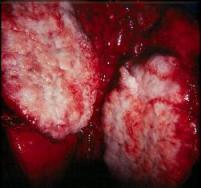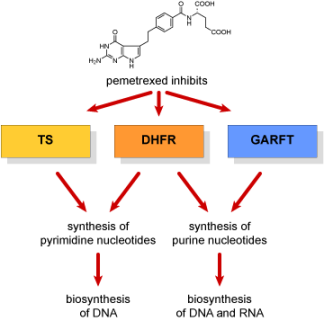There are two main categories of lung cancer.
1. Non–small cell lung carcinoma (NSCLC): About 85 to 87% of lung cancers are in this category. This cancer grows more slowly than small cell lung carcinoma. Nevertheless, by the time about 40% of people are diagnosed, the cancer has spread to other parts of the body outside of the chest.
There are 3 sub-types of NSCLC. The cells in these sub-types differ in size, shape, and chemical make-up.
2. Small cell lung carcinoma (SCLC): Also called oat cell carcinoma, this cancer accounts for about 13 to 15% of all lung cancers. It is very aggressive and spreads quickly. By the time that most people are diagnosed, the cancer has metastasized to other parts of the body.
 Lung cancer has a poor prognosis. On average, people with untreated advanced non–small cell lung cancer (NSCLC) survive 6 months. Even with treatment, people with extensive small cell lung cancer (SCLS) or advanced non–small cell lung cancer (NSCLC) do especially poorly, with a 5-year survival rate of less than 1%.
Lung cancer has a poor prognosis. On average, people with untreated advanced non–small cell lung cancer (NSCLC) survive 6 months. Even with treatment, people with extensive small cell lung cancer (SCLS) or advanced non–small cell lung cancer (NSCLC) do especially poorly, with a 5-year survival rate of less than 1%.
What can you expect during the terminal stages of lung cancer? Is there any way a patient with terminal lung cancer can get better? Sadly.. no. All you can do is pray for a miracle or try experimental drugs.
Second and third line treatment in advanced non-small cell lung cancer.
Fortunately, we have a new option for lung cancer treatment. There are indeed many survivors of stage 4 lung cancer. We have achieved experimental breakthrough in the simultaneous use of Lung-TumorZym and a chemotherapy drug (pemetrexed: Alimta) for treating stage 4 non–small cell lung cancer (NSCLC). The combination therapy led to the remission of non–small cell lung cancer (NSCLC) in most of the treated patients. In contrast, patiens treated with pemetrexed (Alimta) alone never experienced remission.
The combination therapy has been shown to be safe and effective, and is a promising general strategy for treating advanced non–small cell lung cancer (NSCLC) that does not respond to current therapies.The combination therapy establishes a new paradigm for overcoming chemotherapy resistance in non–small cell lung cancer (NSCLC). Because most traditional chemo agents are frequently ineffective against tumors that lack a functional programmed cell death mechanism. Such tumors are said to be chemo-resistant. The evasion of treatment-induced programmed cell death by chemo-resistant tumors has been a major impediment to successful therapeutic outcomes for human cancer.
Lung-TumorZym (LT-Zym) contains an “adaptogenic” mixture of phyto compounds. The active LT-Zym ingredients aim to control, inhibit and destroy lung cancer cells. It is functioning as signal transduction inhibitors, which work by blocking the signals that make cancer cells survive, grow, divide and spread. The right combination of ingredients for the treatment of lung cancer is like a one-two knockout punch in boxing, using one compound to restore the programmed cell death mechanism and a second compound to trigger the process might reduce or eliminate chemo-resistance and be an effective strategy for treating non–small cell lung cancer (NSCLC).
 Pemetrexed (Alimta) is an antifolate that is able to simultaneously inhibit the synthesis of purines and pyrimidines. Purines and pyrimidines are two of the building blocks of nucleic acids. Only two purines and three pyrimidines occur widely in nucleic acids. DNA and RNA are critical components of living cells, and each is made up of nitrogenous bases known as “purines” and “pyrimidines.” These bases are also critical components of momentary cellular energy stores, and without them, many cellular processes could not be accomplished.
Pemetrexed (Alimta) is an antifolate that is able to simultaneously inhibit the synthesis of purines and pyrimidines. Purines and pyrimidines are two of the building blocks of nucleic acids. Only two purines and three pyrimidines occur widely in nucleic acids. DNA and RNA are critical components of living cells, and each is made up of nitrogenous bases known as “purines” and “pyrimidines.” These bases are also critical components of momentary cellular energy stores, and without them, many cellular processes could not be accomplished.
Pemetrexed has been approved for first- and second-line treatment in patients with non-small cell lung cancer (NSCLC). Pemetrexed does have some serious toxic effects, but they can be significantly reduced with folic acid and vitamin B12 supplements.
Pemetrexed: a multitargeted antifolate.
Pemetrexed in the treatment of advanced non-squamous lung cancer.
Pemetrexed in malignant pleural mesothelioma.
Lung-TumorZym (LT-Zym) is a powerful natural medicine (food-grade) for fighting non-small cell lung cancer (NSCLC). LT-Zym plus pemetrexed (Alimta) combination therapy has shown dramatic synergistic anticancer effects. You will be as happily surprised at the results in three weeks. We “guarantee” it. How many (if any) other can say “guarantee” in stage 4 non-small cell lung cancer (NSCLC) treatment? There is no other.